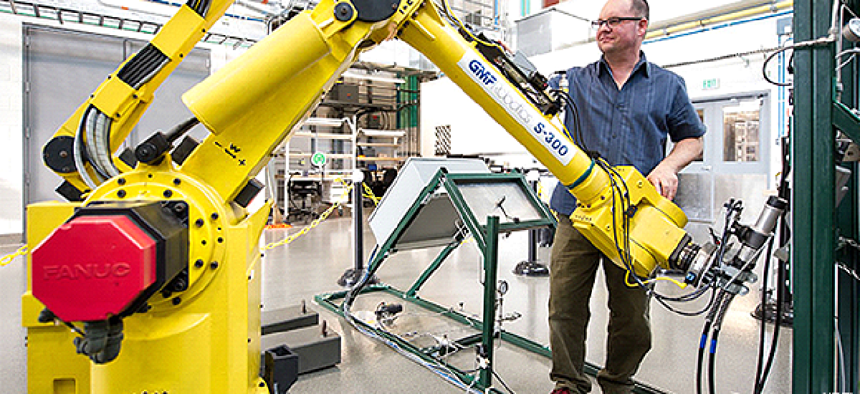NREL calls up down-and-out robot to science big leagues

A team at the National Renewable Energy Laboratory reprogrammed a furniture-building robot to test the hoses that hydrogen-powered vehicles will use when refueling.
The Department of Energy's National Renewable Energy Laboratory is using a Fanuc S300 robot to test hoses used to fill cars' fuel tanks with hydrogen. That's important because starting in 2015 hydrogen-fueled cars are expected to begin to hit the road. And it's especially important because there's only one supplier of the hoses, which are designed to handle the low temperatures and high pressures involved.
That's no big deal. After all, that's the kind of task robots have been doing at auto plants for years. But what makes this story really interesting, is how the project came about and where it's going.
Kevin Harrison, a senior engineer at NREL, got the idea that, as hydrogen autos neared the market, testing the hoses was important. "I thought it was something NREL should do," Harrison said. Problem was, he didn't have a project he could bill the needed equipment to. So he went to eBay.
"I actually purchased the robot with my own money," Harrison said. "It came from the North Carolina Furniture Manufacturing and Management Center, which was just trying to get rid of it."
Since the unit only cost $3,600, Harrison sprung for it. "I thought everyone should have a six-axis robotic arm," he said, tongue firmly in cheek.
After a little troubleshooting and repair of a couple of wires inside the controller, Harrison had the robot working. At the same time, he said, "DOE noticed and wanted to start testing high-pressure hydrogen hoses. So I was actually funded in June 2013 to continue the work." (And yes, he did get reimbursed for the robot.)
Harrison and his team programmed the robot to mimic the bending and twisting motions that people typically do with a hose. "The robotic arm's six axes give you plenty of flexibility to exactly mimic the human refueling pattern," Harrison said.
And Harrison also wanted to do the testing with the hose carrying a high-pressure load. "We want to mimic high-volume refueling, so we're stressing the hose in extra ways to accelerate the aging or the degradation of the hose," he said. "The goal is to cycle the hose every five minutes."
Harrison notes that an efficient fueling system gives hydrogen-powered cars a competitive advantage over electric cars. "If you can do it in 3 to 5 minutes, which is the goal, you have a competitive advantage over electric cars, which take hours," he said.
Higher pressures in the tank also add to that competitive advantage. "We go to higher pressure so that we can get a range of 300 to 400 miles in a fuel cell." Most current electric cars have a range of approximately 100 miles on a charge.
With that in mind, Harrison pointed out that it might be a good idea to simply have the robot continue to fill cars instead of turning it over to humans. “That's what we’re working toward for next year,” he said.





